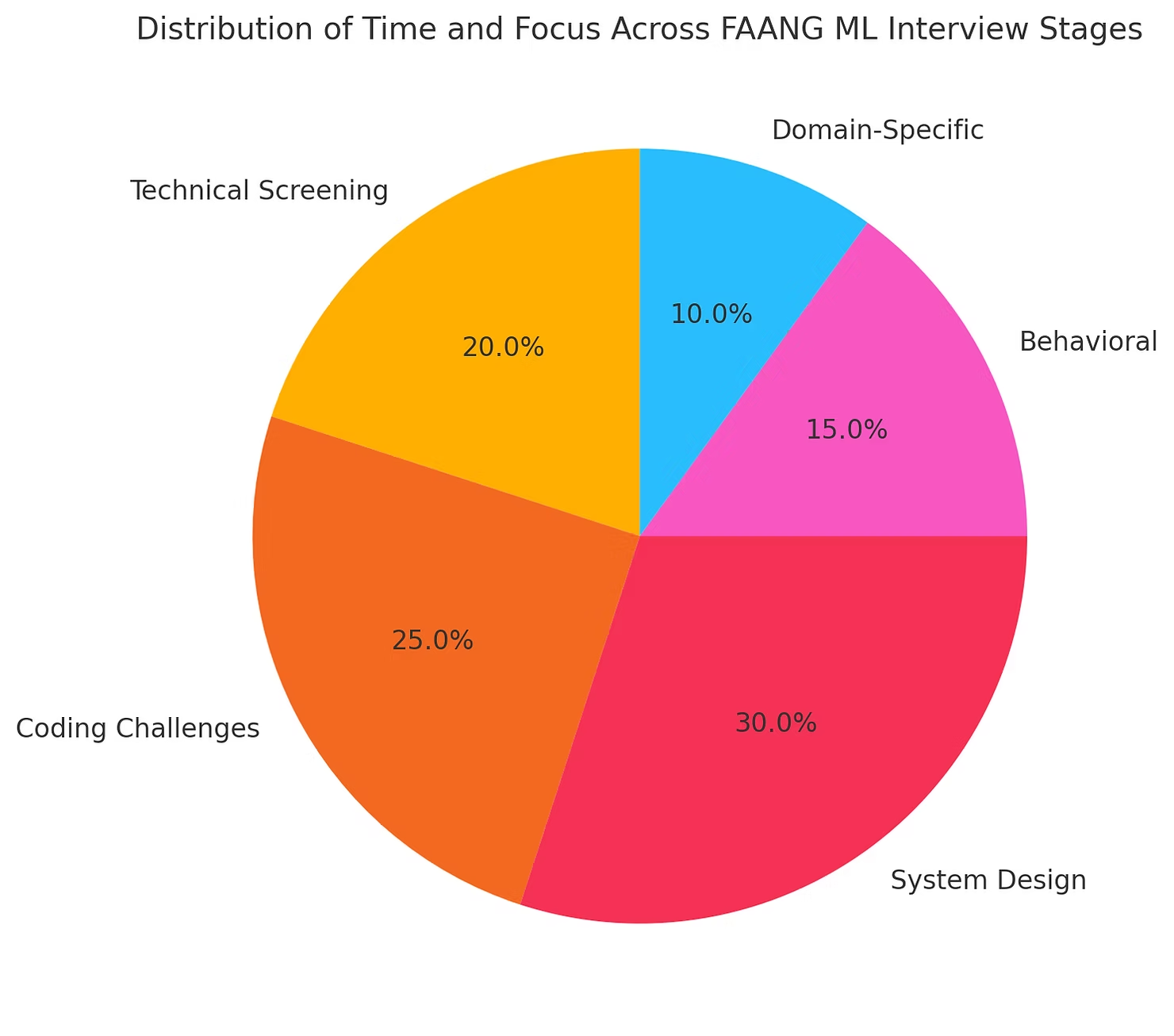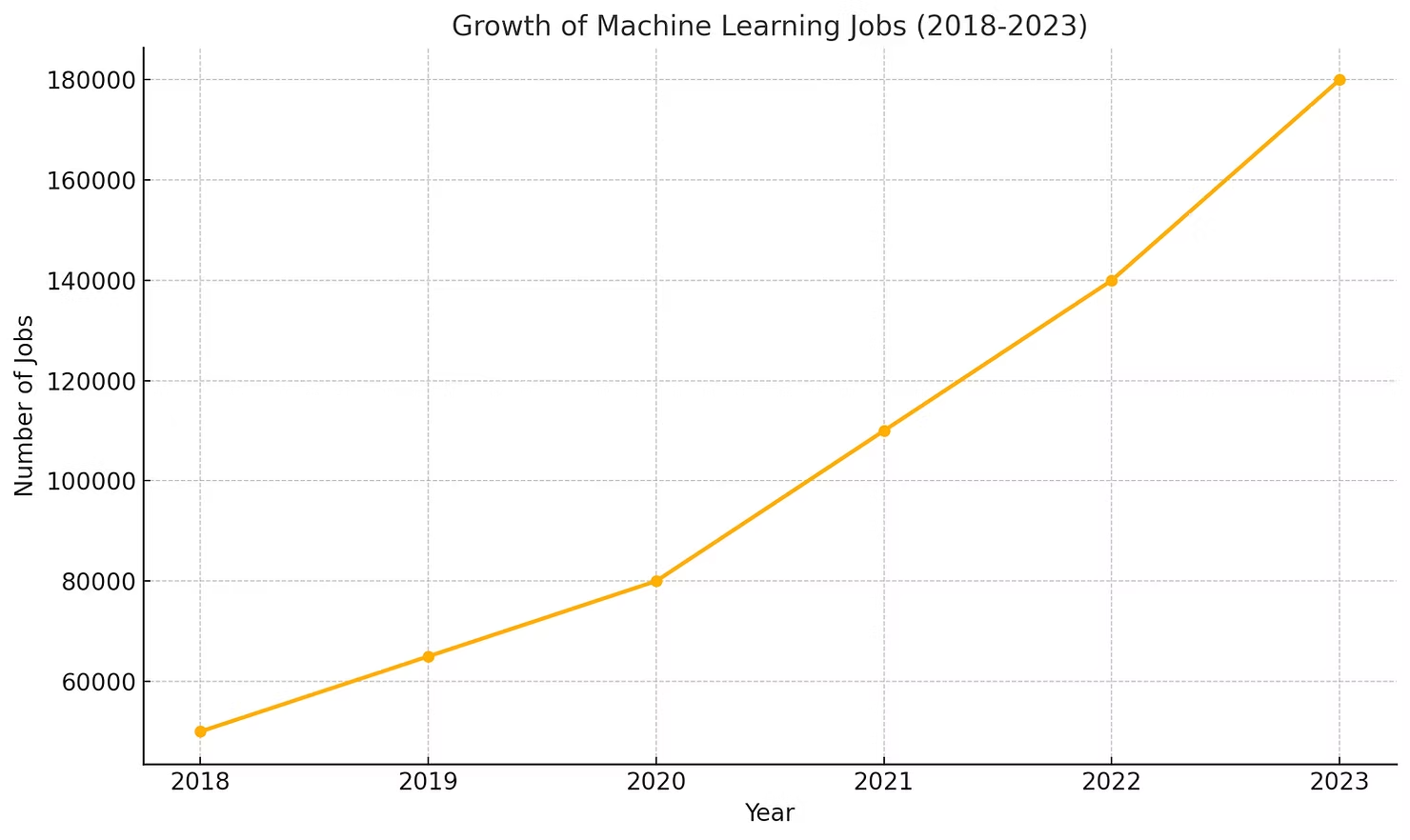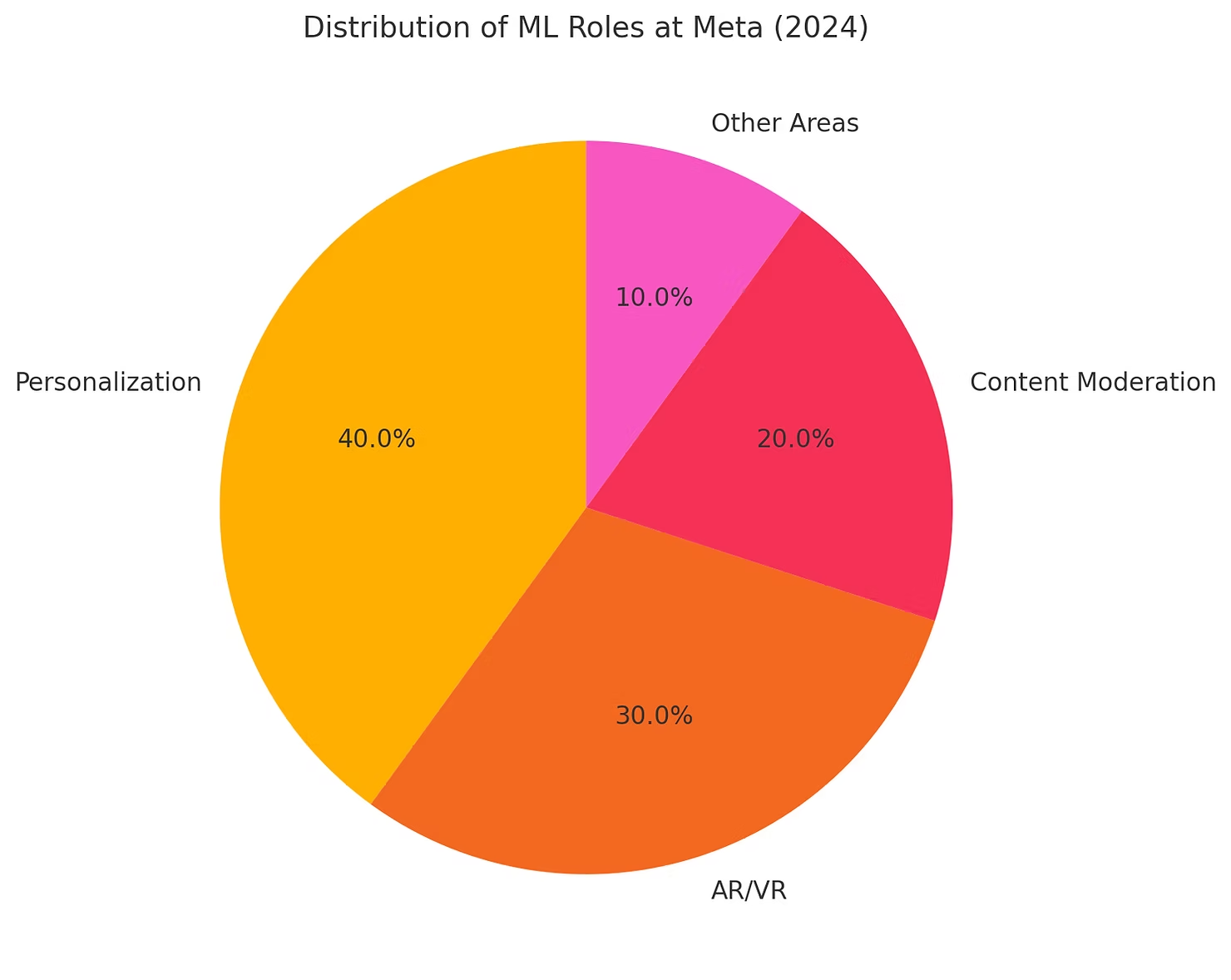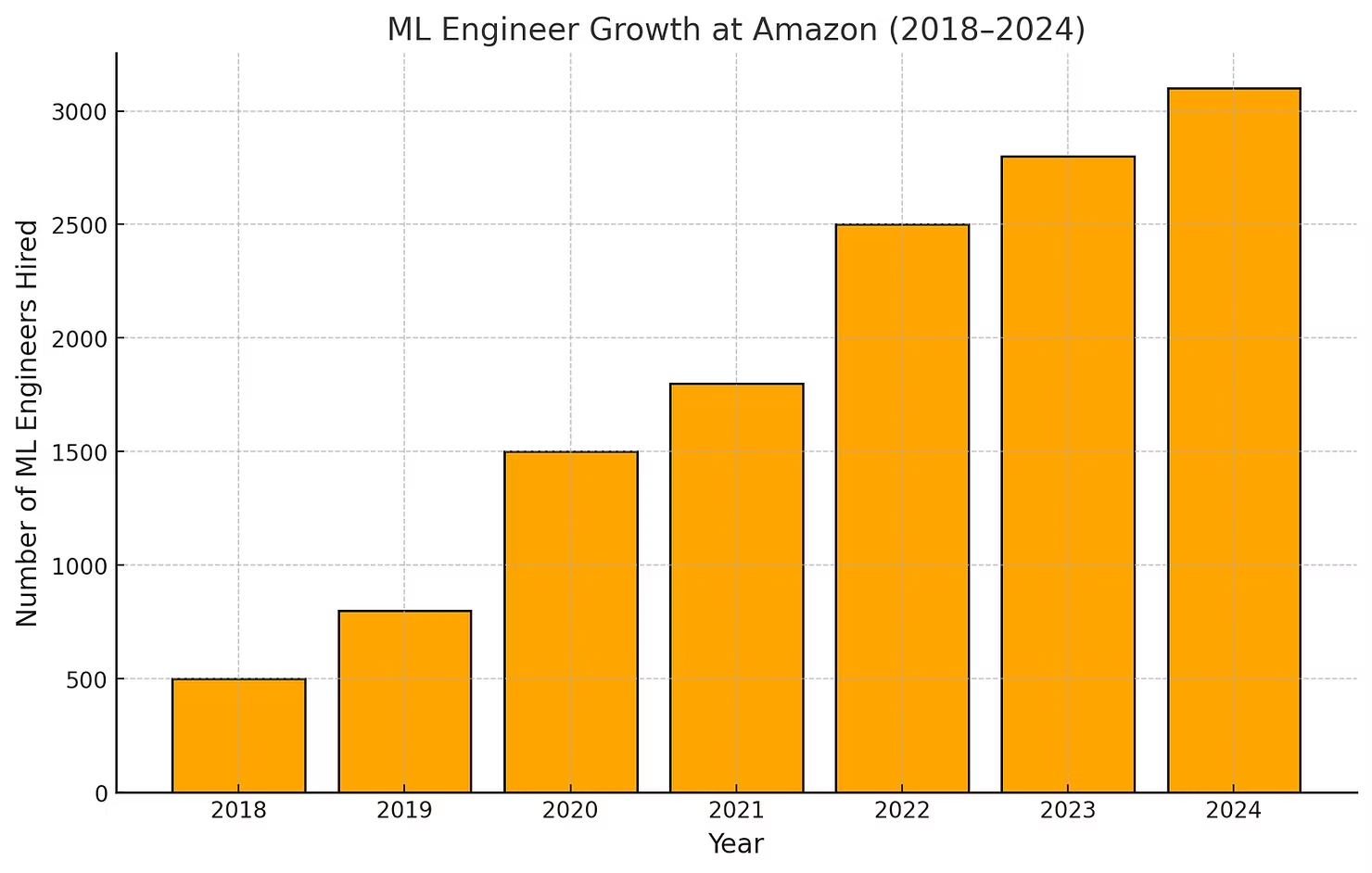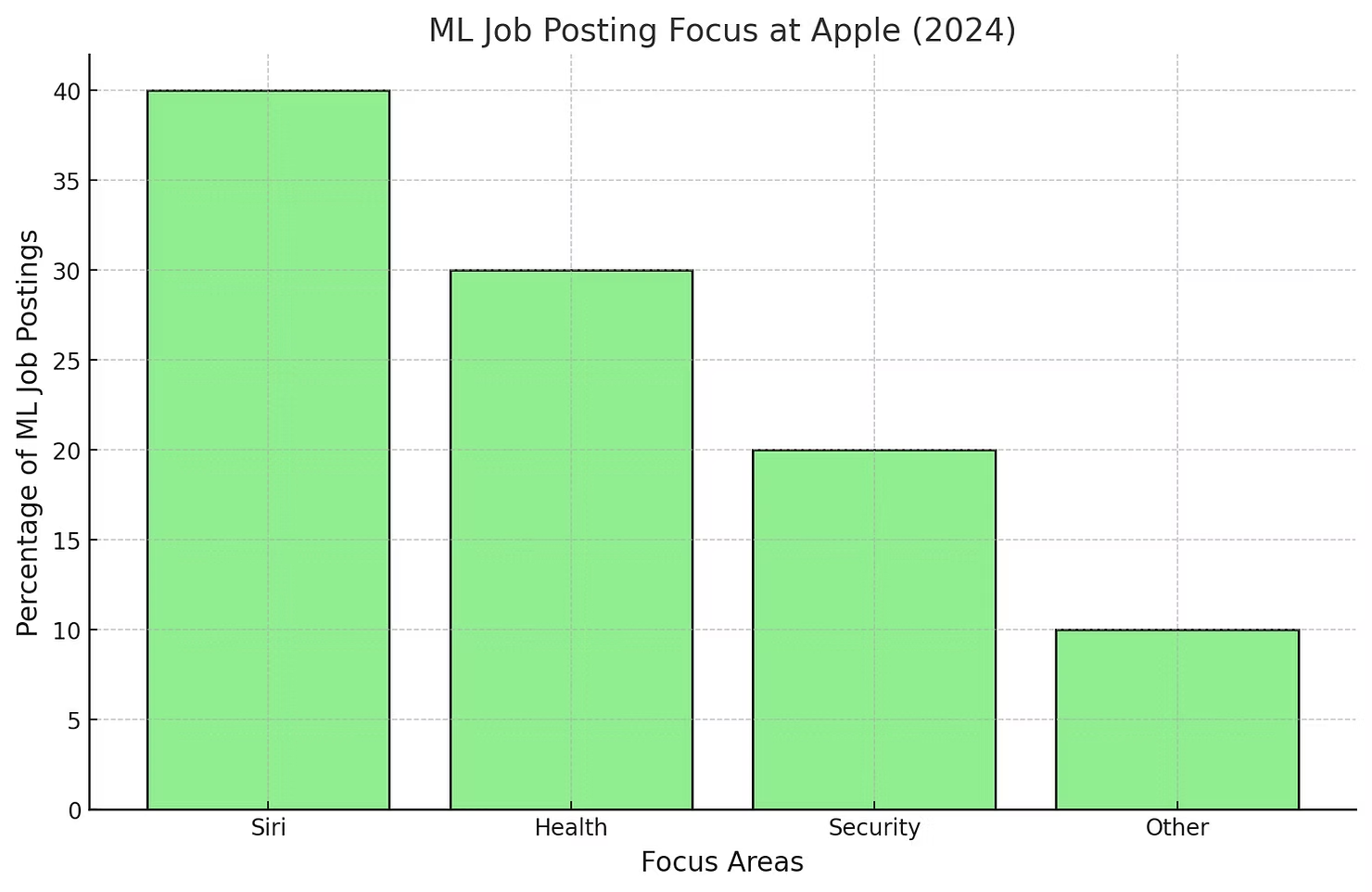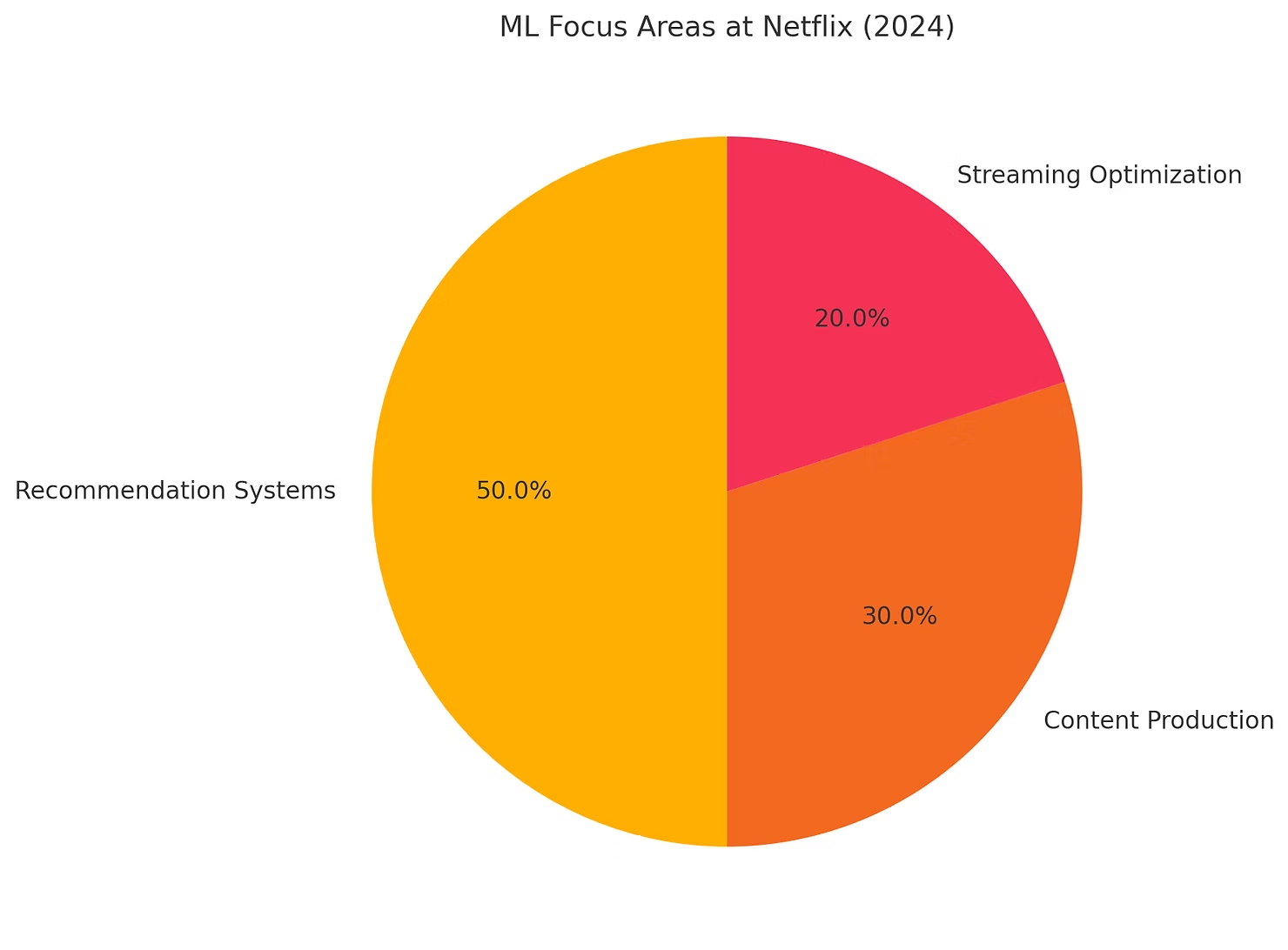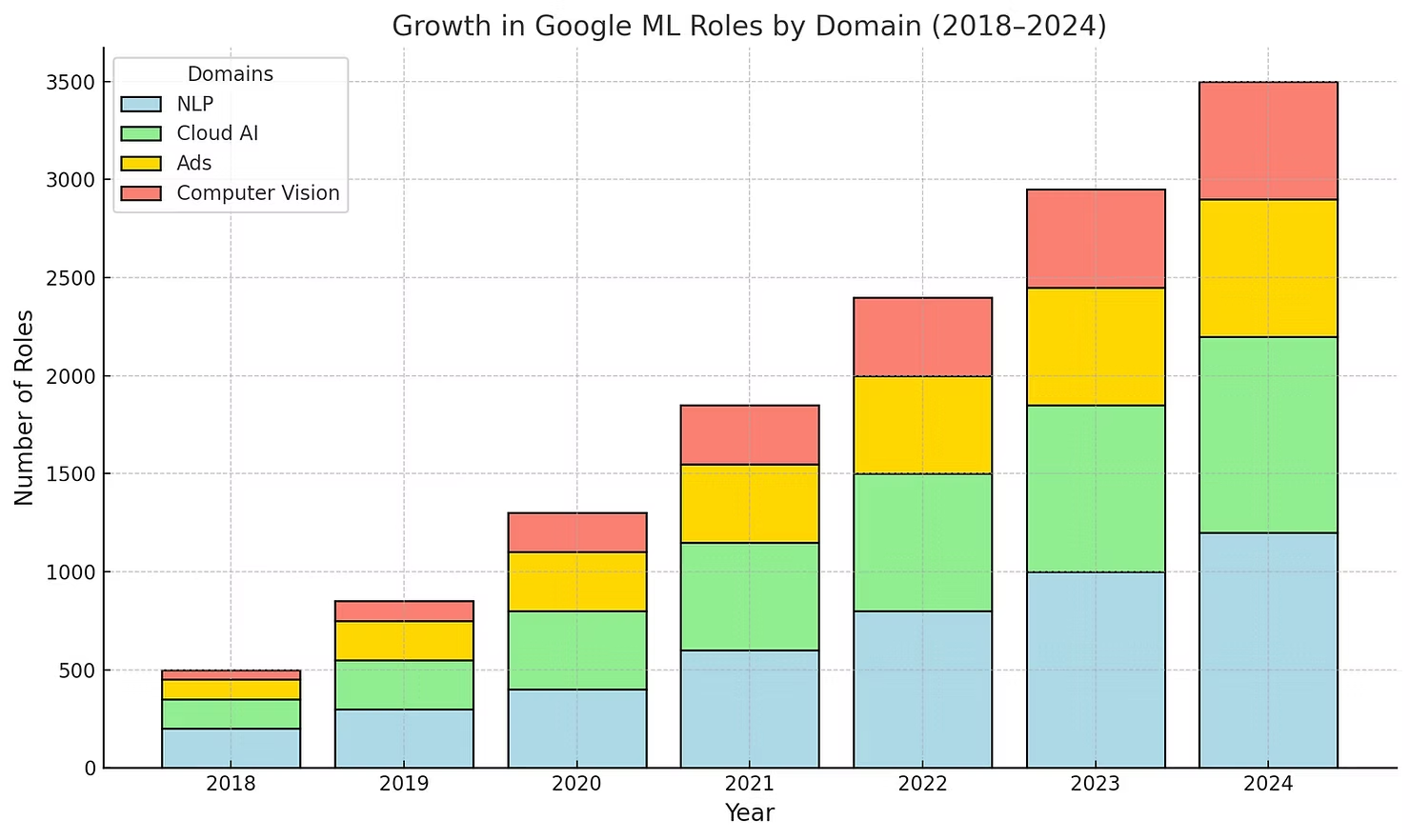Landing a machine learning (ML) role at FAANG
(Facebook, Amazon, Apple, Netflix, and Google) is one of the most coveted goals for software engineers.
Beyond the exceptional salaries and benefits, FAANG companies offer engineers the chance to work on
groundbreaking technologies that shape industries and lives.
But cracking an ML interview at these companies
is no easy feat. The process is rigorous and tests not only your technical knowledge but also your ability
to think strategically, collaborate effectively, and solve real-world problems at scale.
In this crash course, we’ll take you through
everything you need to know—from understanding the interview process to preparing with laser-sharp focus.
Along the way, we’ll share strategies, resources, and tools that will make your journey smoother and
increase your odds of success.
1. The Landscape
of ML Interviews at FAANG
Why FAANG ML Roles
Are the Gold Standard
Landing a machine learning (ML) role at one of
the FAANG companies—Facebook (now Meta), Amazon, Apple, Netflix, and Google—represents a pinnacle
achievement in the tech industry. These organizations are synonymous with cutting-edge research,
technological innovation, and products that touch billions of lives. Here’s why these roles are so sought
after:
-
Impactful
Projects:
-
At Google, ML
powers products like Google Translate, Google Photos, and Search, which serve billions of
users globally.
-
Facebook uses ML
to improve News Feed personalization, detect hate speech, and develop advanced AR/VR
systems.
-
Amazon relies on
ML to optimize its recommendation engine, streamline logistics, and enhance Alexa’s
capabilities.
-
Apple applies ML
for on-device privacy-preserving algorithms, powering Siri, and advancing health monitoring
features in Apple Watch.
-
Netflix uses
sophisticated algorithms to personalize viewing recommendations and optimize its production
pipeline through audience analysis.
-
These companies
lead the charge in democratizing AI through open-source libraries such as TensorFlow
(Google), PyTorch (Meta), and AWS Machine Learning (Amazon).
-
Exceptional
Compensation:
-
FAANG companies
offer some of the highest salaries in the industry. Total compensation for an ML engineer
can exceed $300,000 annually, thanks to lucrative stock options, performance bonuses, and
perks.
-
These packages
outpace industry averages, making these roles financially rewarding.
-
Access to
Unparalleled Resources:
-
The sheer scale
of data at FAANG companies is a dream for any ML professional. Facebook handles 4 petabytes
of data per day, while Google processes over 3.5 billion searches daily.
-
These companies
invest billions in AI research and infrastructure, allowing ML engineers to work with the
latest hardware, cloud platforms, and datasets.
-
Many FAANG ML
engineers co-author research papers and participate in top AI conferences, ensuring they
remain at the forefront of the field.
-
Career
Development Opportunities:
-
Working
alongside world-class engineers and researchers accelerates personal and professional
growth.
-
FAANG companies
provide avenues for upward mobility, whether transitioning into leadership roles or
exploring specialized fields like natural language processing (NLP), computer vision, or
reinforcement learning.
What Makes FAANG
ML Interviews Unique?
The FAANG interview process is notoriously
rigorous, designed to identify candidates who are not just technically proficient but also capable of
solving real-world problems at scale. Here’s what sets these interviews apart:
-
Emphasis on
Scale:
-
FAANG ML
engineers work on systems that need to operate seamlessly at the scale of billions of users.
Interview questions often reflect this requirement, asking candidates to optimize models for
latency, memory usage, or scalability.
-
Real-World
Application:
-
Interdisciplinary Focus:
-
ML roles at
FAANG require knowledge spanning multiple domains: computer science, mathematics,
statistics, and domain-specific expertise (e.g., e-commerce, social networks, or
multimedia).
-
Behavioral
Competency:
What Does a
Typical FAANG ML Interview Look Like?
The FAANG ML interview process typically spans
multiple rounds, each designed to test specific skills. Let’s break down each stage:
-
Resume
Screening:
-
Recruiters look
for strong academic credentials, relevant work experience, and evidence of ML expertise
(e.g., projects, publications, certifications).
-
Pro Tip: Tailor
your resume to highlight accomplishments that align with the role. Use quantifiable metrics
to demonstrate impact, such as “Improved recommendation accuracy by 15% using collaborative
filtering.”
-
Technical
Screening:
-
Format: A 45–60
minute online coding interview focusing on algorithms and data structures.
-
Example
Question: “Implement a function to find the shortest path in a weighted graph.”
-
Purpose:
Evaluate problem-solving ability, coding fluency, and familiarity with foundational
concepts.
-
Coding
Challenges:
-
Format: These
may include live coding sessions or take-home assignments.
-
Example
Question: “Implement a decision tree classifier and explain your design choices.”
-
Purpose: Assess
a candidate’s ability to apply ML algorithms to solve practical problems.
-
System
Design:
-
Format: A
discussion where the candidate designs a scalable ML system.
-
Example Problem:
“Design a recommendation engine for an e-commerce website. How would you ensure it handles
millions of queries per second?”
-
Purpose: Test
knowledge of distributed systems, model deployment, and real-time inference.
-
Behavioral
Interviews:
-
Format:
Conversational, with questions about past experiences, teamwork, and conflict
resolution.
-
Example
Question: “Describe a time when you disagreed with a teammate. How did you resolve
it?”
-
Purpose:
Determine cultural fit and assess soft skills.
-
Domain-Specific
Deep Dive:
-
Format: An
in-depth discussion about the candidate’s expertise in a particular ML domain.
-
Example
Question: “How would you optimize hyperparameters for a deep learning model?”
-
Purpose: Gauge
depth of knowledge and ability to innovate.
What Do
Interviewers Look For?
FAANG interviewers evaluate candidates on
multiple axes:
-
Technical
Skills:
-
Problem-Solving
Ability:
-
Communication
Skills:
-
Growth
Mindset:
How Do FAANG ML
Interviews Differ by Company?
While the overall process is similar across
FAANG, each company has unique nuances:
-
Google:
Focuses heavily on scalability and optimization problems, reflecting its emphasis on high-traffic
systems.
-
Amazon:
Stresses alignment with its Leadership Principles, such as customer obsession and ownership.
-
Meta:
Places a strong emphasis on impact-driven ML, often asking candidates to consider ethical
implications of their designs.
-
Netflix: Tests for expertise in personalization algorithms and
multimedia data processing.
-
Apple:
Prioritizes privacy-preserving ML techniques and on-device learning due to its commitment to user
privacy.
Pro Tips for
Navigating the FAANG ML Interview Process
-
Tailor Your
Preparation:
-
Master
Fundamentals:
-
Mock
Interviews:
Data Insight:
Breakdown of FAANG ML Interview Rounds
2. Core Skills
Tested in FAANG ML Interviews
The FAANG ML interview process rigorously
evaluates candidates across a broad spectrum of skills. These assessments are designed to test not only
technical proficiency but also problem-solving ability, creativity, and practical application of machine
learning techniques at scale. Let’s break down the core skills that candidates need to master and explore
actionable tips for excelling in each area.
1. Algorithms and
Data Structures
Though ML engineers often focus on model design
and optimization, algorithms and data structures remain foundational. Many technical interviews, including
those at FAANG, begin with coding challenges that require mastery of these topics.
Key Topics to
Master:
How to
Prepare:
-
Practice
Regularly: Use platforms like Leetcode, HackerRank, or InterviewNode to solve problems
tagged for “FAANG ML interviews.”
-
Visualize
Problems: Draw diagrams to clarify problem requirements and optimize your
approach.
2. Probability and
Statistics
Statistical intuition is critical for ML
engineers, as most ML algorithms are rooted in probabilistic concepts. FAANG interviews often test your
ability to model uncertainty, draw inferences, and design experiments.
Key Topics to
Master:
Real-World
Application:
How to
Prepare:
3. Machine
Learning Fundamentals
This is the centerpiece of FAANG ML interviews.
You’ll need to demonstrate a deep understanding of core ML principles, from model selection to performance
evaluation.
Key Topics to
Master:
-
Core
Algorithms:
-
Linear
Regression, Logistic Regression, Decision Trees, Support Vector Machines (SVMs).
-
Example
Question: “Explain the difference between bagging and boosting.”
-
Advanced
Techniques:
-
Convolutional
Neural Networks (CNNs) for computer vision tasks.
-
Recurrent Neural
Networks (RNNs) and transformers for natural language processing (NLP).
-
Clustering
methods like K-Means and DBSCAN.
-
Model
Evaluation:
-
Metrics:
Accuracy, Precision, Recall, F1-Score, AUC-ROC.
-
Bias-Variance
Tradeoff: Explain underfitting vs. overfitting and strategies to address them.
Real-World
Application:
-
Using CNNs to detect
objects in images.
-
Implementing
recommendation systems for e-commerce platforms.
-
Building anomaly
detection models for fraud prevention.
How to
Prepare:
-
Build
Projects: Create ML models from scratch and document your process.
-
Stay
Updated: Follow blogs like “Towards Data Science” and platforms like “Papers With Code”
to learn about new ML advancements.
4. Big Data and
Infrastructure
At FAANG, ML systems must process vast amounts of
data in real-time, requiring engineers to have expertise in distributed systems and data engineering.
Key Topics to
Master:
Real-World
Application:
How to
Prepare:
-
Hands-On
Practice: Use cloud platforms like AWS or GCP to implement small-scale distributed
systems.
-
Understand
Trade-Offs: Study the advantages and limitations of different storage and computing
approaches.
5. Domain-Specific
Knowledge
FAANG ML roles often require expertise in
specific areas like NLP, computer vision, or reinforcement learning. Tailor your preparation to the focus
area of the job you’re applying for.
Key Topics by
Domain:
How to
Prepare:
6. Soft Skills and
Behavioral Traits
Technical knowledge is crucial, but FAANG places
equal emphasis on soft skills. Behavioral interviews test your ability to collaborate, lead, and thrive in a
high-pressure environment.
Key Skills to
Demonstrate:
How to
Prepare:
-
Use the STAR framework
(Situation, Task, Action, Result) to craft responses.
-
Rehearse your answers
for common behavioral questions with a peer or mentor.
How to Excel
Across These Core Skills
-
Tailor Your
Preparation:
-
Identify which
skills are most relevant to the job description.
-
Allocate 40% of
your preparation time to ML fundamentals, 30% to algorithms, 20% to big data, and 10% to
soft skills.
-
Use
Feedback:
-
Stay
Consistent:
3. Step-by-Step
Crash Course
Cracking a FAANG ML interview requires more than
just technical knowledge; it demands a structured approach to preparation. This step-by-step crash course
provides a roadmap for mastering the essential skills and concepts needed to succeed. By breaking the
process into manageable phases, you can systematically tackle the challenges of FAANG ML interviews.
Phase 1: Core
Concepts and Foundations
Why It
Matters:
The foundation of your success lies in
solidifying the fundamentals. These core concepts are the bedrock of all ML applications and
interviews.
What to Focus
On:
-
Computer Science
Basics:
-
Refresh your
understanding of data structures like arrays, trees, and hash maps.
-
Revisit
algorithms such as sorting (quicksort, mergesort) and searching (binary search).
-
Understand time
and space complexity to optimize solutions.
-
Mathematics for
ML:
-
Linear
Algebra: Study vectors, matrices, eigenvalues, and singular value decomposition
(SVD). These are critical for understanding ML algorithms like PCA and neural
networks.
-
Calculus: Focus on gradients, partial derivatives, and
optimization techniques like gradient descent.
-
Probability and Statistics: Review Bayes’ theorem,
probability distributions, and hypothesis testing.
-
Coding
Practice:
Pro
Tips:
-
Start with simple coding
challenges to build confidence, then gradually move to advanced problems.
-
Use visualization tools
like Python’s matplotlib or graph paper to diagram your approach to problems.
Recommended
Resources:
-
Introduction to
Algorithms by Cormen et al.
-
MIT OpenCourseWare:
Linear Algebra.
-
Khan Academy:
Probability and Calculus.
Phase 2: Mastering
Machine Learning
Why It
Matters:
Machine learning expertise is the centerpiece of
FAANG ML roles. Interviewers expect candidates to understand algorithms inside-out and demonstrate practical
problem-solving skills.
What to Focus
On:
-
Core ML
Algorithms:
-
Supervised Learning:
-
Unsupervised Learning:
-
Deep
Learning:
-
Optimization
Techniques:
-
Master gradient
descent, learning rate schedules, and backpropagation.
-
Experiment with
hyperparameter tuning using grid search or random search.
-
Model
Evaluation:
-
Understand
metrics like precision, recall, F1-score, and AUC-ROC.
-
Practice
interpreting confusion matrices and addressing class imbalance.
-
Hands-On
Practice:
Pro
Tips:
Recommended
Resources:
-
Deep Learning by Ian
Goodfellow.
-
Coursera: Machine
Learning by Andrew Ng.
-
Kaggle: Competitions
and datasets for hands-on practice.
Phase 3: System
Design for ML
Why It
Matters:
FAANG ML engineers are often tasked with
designing and scaling systems to handle massive datasets and real-time processing. This phase prepares you
for such challenges.
What to Focus
On:
-
Key
Concepts:
-
Data
Pipelines:
-
Design
workflows to preprocess and transform data efficiently.
-
Tools:
Apache Airflow, Spark, and Pandas.
-
Distributed Systems:
-
Learn
how to use Hadoop and Spark for distributed storage and processing.
-
Explore
techniques for sharding, replication, and load balancing.
-
Model
Deployment:
-
Problem
Examples:
Pro
Tips:
-
Always consider
scalability, latency, and fault tolerance in your designs.
-
Familiarize yourself
with trade-offs in storage, computation, and communication.
Recommended
Resources:
-
Designing
Data-Intensive Applications by Martin Kleppmann.
-
Grokking the System
Design Interview.
-
AWS/GCP free tiers for
experimenting with cloud-based solutions.
Phase 4:
Behavioral Preparation and Mock Interviews
Why It
Matters:
FAANG interviews emphasize cultural fit,
problem-solving under pressure, and teamwork. Behavioral interviews are as important as technical
assessments.
What to Focus
On:
-
Behavioral
Questions:
-
Prepare answers
for questions like:
-
Use the STAR
(Situation, Task, Action, Result) framework for structured and impactful responses.
-
Mock
Interviews:
-
Iterative
Improvement:
-
Record your
mock interviews to identify gaps in communication or technical clarity.
-
Seek feedback
on areas like time management, problem-solving approach, and presentation.
Pro
Tips:
-
Align your answers with
the company’s values (e.g., Amazon’s Leadership Principles, Google’s “focus on the user”).
-
Practice explaining
your thought process clearly to interviewers, especially for open-ended questions.
Sample 12-Week
Crash Course Schedule
Below is an example of a structured 12-week
preparation plan:
|
|
|
|
|
|
Algorithms & Data Structures
|
Solve problems on Leetcode (medium/hard).
|
|
|
Machine Learning Fundamentals
|
Study core ML algorithms and build small projects.
|
|
|
|
Practice gradient descent, backpropagation.
|
|
|
|
Design data pipelines and distributed systems.
|
|
|
|
Deploy a model on AWS/GCP.
|
|
|
|
Practice STAR responses and align with values.
|
|
|
|
Conduct 5–7 mock interviews with peers/mentors.
|
How to Stay on
Track
-
Set
Milestones:
-
Leverage
Feedback:
-
Balance Breadth
and Depth:
4. Common
Challenges and How to Overcome Them
Preparing for a FAANG ML interview can feel like
navigating a maze, with numerous obstacles that test your technical skills, time management, and mental
resilience. Identifying these challenges early and knowing how to address them can make the preparation
process more manageable and increase your chances of success. Below is an in-depth exploration of the most
common challenges candidates face and actionable strategies to overcome them.
Challenge 1:
Balancing Breadth vs. Depth
The
Problem:
FAANG ML interviews demand knowledge across a
broad spectrum of topics—data structures, algorithms, probability, machine learning fundamentals, system
design, and even soft skills. Trying to master every topic can feel overwhelming.
Why It’s a
Challenge:
-
Some candidates focus
too much on breadth, leading to shallow knowledge in critical areas.
-
Others dive deeply into
one subject (e.g., neural networks) but neglect other essential topics (e.g., system design or
coding).
How to Overcome
It:
-
Identify
Role-Specific Focus Areas:
-
Adopt the 80/20
Rule:
-
Dedicate 80% of
your time to the most commonly tested topics, such as algorithms, ML models, and system
design.
-
Spend 20% on
less common but still valuable areas, like NLP or reinforcement learning.
-
Use a Weighted
Study Plan:
Pro
Tip:
Challenge 2:
Managing Time Effectively
The
Problem:
Balancing preparation for a FAANG ML interview
alongside work, family, or other commitments can be a major hurdle. The extensive material to cover often
leaves candidates feeling stretched thin.
Why It’s a
Challenge:
-
Many candidates lack a
structured plan, leading to wasted time on less impactful topics.
-
Procrastination and
burnout are common due to the high stakes and demanding workload.
How to Overcome
It:
-
Create a Weekly
Schedule:
-
Leverage
Productivity Tools:
-
Adopt the
Pomodoro Technique:
-
Set
Milestones:
Pro
Tip:
Challenge 3:
Impostor Syndrome
The
Problem:
Impostor syndrome—a persistent belief that you
are not “good enough” despite evidence of your abilities—can sabotage your preparation. Many candidates feel
intimidated by the thought of competing against other highly qualified individuals.
Why It’s a
Challenge:
-
Impostor syndrome leads
to self-doubt, procrastination, and stress, which can derail even the best-prepared
candidates.
-
Candidates often
compare themselves to others, especially those who’ve already succeeded in landing FAANG
roles.
How to Overcome
It:
-
Focus on Your
Strengths:
-
Reframe Your
Perspective:
-
Set Realistic
Expectations:
-
Recognize that
even the most talented candidates need multiple attempts to succeed at FAANG
interviews.
-
Example: Jeff
Dean, a legendary Google engineer, wasn’t hired on his first attempt.
-
Seek
Support:
Pro
Tip:
Challenge 4:
Overcoming Behavioral Interview Anxiety
The
Problem:
Behavioral interviews are often overlooked in
preparation, leading to poor performance. Many candidates find it difficult to articulate their experiences
or align their answers with company values.
Why It’s a
Challenge:
How to Overcome
It:
-
Understand the
STAR Framework:
-
Use STAR
(Situation, Task, Action, Result) to structure your answers clearly.
-
Example
Question: “Tell me about a time you worked under tight deadlines.”
-
Situation: “Our team had a 2-week deadline to deliver a client-facing
dashboard.”
-
Task:
“I was responsible for integrating the ML model predictions into the UI.”
-
Action:
“I collaborated with the front-end team to optimize API calls.”
-
Result:
“We delivered on time, and the client reported a 25% improvement in
efficiency.”
-
Align Answers
with Company Values:
-
Practice
Behavioral Questions:
Pro
Tip:
Challenge 5:
Navigating System Design Interviews
The
Problem:
System design interviews are challenging because
they require interdisciplinary knowledge of ML, distributed systems, and real-world scalability.
Why It’s a
Challenge:
How to Overcome
It:
-
Learn
Frameworks:
-
Practice with
Examples:
-
Explain
Trade-Offs:
Pro
Tip:
Overarching Tips
for Overcoming Challenges
-
Leverage
Feedback:
-
Stay
Consistent:
-
Celebrate Small
Wins:
5. Tools and
Resources
The right tools can accelerate your FAANG ML
preparation. Below is an expanded guide to essential resources.
Books
Online
Platforms
-
Leetcode:
-
Kaggle:
-
Papers With
Code:
-
InterviewNode:
(Include table comparing platforms based on
cost, focus areas, and key features.)
Pro
Tip:
Create a daily learning routine: Spend 30% of
your time coding, 40% on ML concepts, and 30% on system design.
6. Data and
Trends in ML Hiring
The demand for machine learning (ML) engineers at
FAANG companies has grown exponentially over the past decade, driven by advancements in artificial
intelligence (AI) and the ever-increasing importance of data-driven decision-making. Understanding the
hiring trends, growth patterns, and focus areas for each FAANG company can help candidates tailor their
preparation and align with market demands.
In this expanded section, we’ll explore hiring
trends across FAANG companies, provide company-specific insights, and incorporate graphs to visualize the
data.
1. Overall Growth
in ML Hiring
Industry
Trends:
-
Between 2018 and 2023,
the demand for ML roles across FAANG increased by 45%, according to LinkedIn job postings.
-
ML roles are among the
highest-paid technical positions, with an average base salary of $170,000 and total compensation
often exceeding $300,000.
Graph: ML Job
Postings Growth (2018–2023)
2.
Company-Specific ML Hiring Trends
Meta
(Facebook)
Meta heavily invests in ML for improving user
engagement and building next-gen AR/VR technologies like Oculus and the Metaverse. Core areas
include:
-
Personalization:
Enhancing News Feed, Reels, and ad-targeting algorithms.
-
Content Moderation:
Using ML to detect hate speech, misinformation, and inappropriate content.
-
AR/VR: Developing
computer vision models for immersive virtual experiences.
-
Meta increased ML
hiring by 38% from 2021 to 2023, focusing on AR/VR and NLP roles.
-
Average ML engineer
compensation at Meta is $180,000 (base salary) with stock options and bonuses pushing the total to
$350,000+.
Amazon
Amazon leverages ML across its vast ecosystem,
including:
-
E-commerce: Building
recommendation engines to boost product visibility.
-
AWS: Providing
ML-as-a-service through platforms like SageMaker.
-
Operations: Optimizing
logistics and supply chain through predictive models.
-
Alexa: Developing NLP
models to enhance voice recognition and conversational AI.
-
Amazon employs over
12,000 ML engineers, the largest among FAANG.
-
ML hiring grew by 42%
between 2020 and 2023, driven by demand for AWS AI solutions and voice-enabled devices.
Apple
Apple’s ML focus is unique due to its emphasis on
privacy-preserving algorithms and on-device learning. Key areas include:
-
Siri: Enhancing voice
recognition and natural language understanding.
-
Health: ML-powered
features in Apple Watch, like fall detection and ECG analysis.
-
Security: On-device AI
for Face ID and fingerprint authentication.
-
Apple has seen a 30%
increase in ML job postings since 2021, with a strong focus on AI-driven health features.
-
ML engineers at Apple
earn an average base salary of $200,000, reflecting the company’s premium compensation for
specialized talent.
Netflix
Netflix relies heavily on ML to deliver a highly
personalized user experience and optimize its content production pipeline. Core ML applications
include:
-
Recommendation Systems:
Suggesting shows and movies tailored to user preferences.
-
Content Production:
Using ML models to predict the success of scripts, optimize production schedules, and manage
budgets.
-
Streaming Optimization:
Enhancing video quality and reducing buffering with real-time ML.
-
Netflix increased its
ML hiring by 35% between 2020 and 2023, with a primary focus on recommendation algorithms.
-
The average ML engineer
compensation at Netflix is $190,000, with a strong bonus structure tied to performance.
Google
Google is a leader in AI/ML research and
deployment, with its products powered by sophisticated ML models. Key applications include:
-
Search and Ads:
Improving ranking algorithms and click-through rates.
-
Google Cloud AI:
Offering scalable ML solutions to external customers.
-
NLP: Advancing models
like BERT for Google Translate, Google Assistant, and Gmail autocomplete.
-
Computer Vision:
Powering Google Photos, autonomous vehicles, and healthcare initiatives.
-
Google’s ML hiring
surged by 50% between 2018 and 2023, with a focus on cloud AI and NLP roles.
-
Google offers the
highest average ML engineer base salary, at $200,000, with total compensation often exceeding
$400,000.
3. Compensation
Trends in ML Hiring
FAANG vs.
Industry
FAANG companies consistently offer the most
competitive salaries for ML engineers. Below is a comparison of average ML engineer compensation (base
salary + stock + bonuses) at FAANG vs. the rest of the tech industry:
-
FAANG
Average: $300,000–$400,000 total compensation.
-
Non-FAANG
Industry Average: $150,000–$200,000 total compensation.
Graph: ML Engineer Compensation
Comparison (FAANG vs. Non-FAANG) (Bar chart comparing total compensation at FAANG vs. other tech
companies.)
4. Emerging
Trends in FAANG ML Hiring
Increased Focus
on Ethical AI:
Shift Toward
Privacy-Preserving ML:
Rise of
Domain-Specific Roles:
Remote ML
Roles:
Graph: Remote ML Job Postings by
FAANG Companies (2018–2023) (Line graph showing the percentage of remote ML jobs over time.)
7. InterviewNode:
Your Secret Weapon for FAANG ML Interviews
InterviewNode is more than a platform; it’s your
personal coach for cracking FAANG ML interviews. Here’s how it helps:
Customized
Learning Plans
Every candidate has unique strengths and
weaknesses. InterviewNode designs tailored study plans to address gaps and maximize efficiency.
1-on-1
Mentorship
Learn directly from FAANG engineers who’ve been
through the process. Sessions focus on:
Mock
Interviews
Simulate the real interview environment with mock
sessions that:
8.
Conclusion
Breaking into FAANG as an ML engineer may feel
daunting, but with the right preparation, it’s achievable. This crash course provides the roadmap you
need—follow it, stay disciplined, and don’t hesitate to seek expert guidance.


